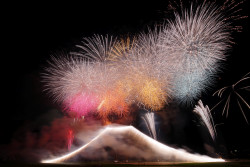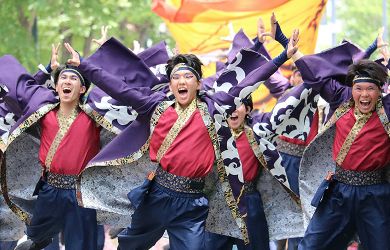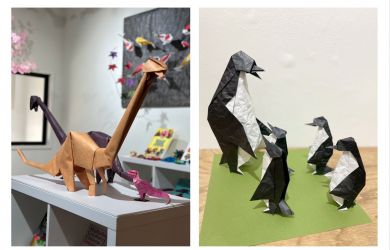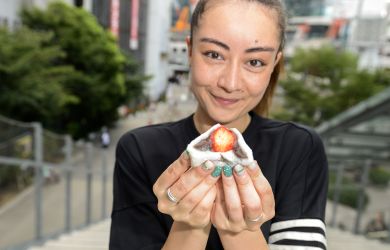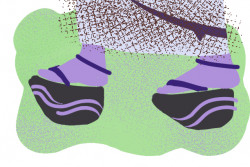
February 5, 2009
The Tricksters of Tokyo
With dozens of magic bars and a small army of illusionists, Tokyo has a whole lot of tricks up its sleeve
By Shaun Davies
Originally published on metropolis.co.jp on February 2009

Issey Maya (left), Leo and Kaori light it up
Photo by Scott Larson
Master magician Issey Maya pulls a chopping knife from his jacket pocket and picks the kiwi off the table with just a hint of a smile. The four audience members in his small bar lean forward—we all know what’s coming, but it seems scarcely believable. How could that ¥1,000 note, which was in a zip-up wallet only 30 seconds before, now be buried in the guts of a piece of fruit?
Maya plunges the knife into the kiwi and slices it in two. Sure enough, the note is buried in its juicy heart. “Sugoi… sugoi,” murmurs its owner, a cheerful middle-aged salaryman. He picks up the fruit and examines it—there are no visible irregularities. Maya carefully wipes down the note with an oshibori before handing it back with a nod of thanks.
We’re in Conjuror’s, a magic bar in the heart of Ginza, well after the nearby subway stations have rolled down their doors. Each night, the bar is filled with a mix of Ginza characters—cashed-up salarymen, fashion-forward women, even hostesses—looking for a break from the regular round of izakaya and karaoke bars.
Conjuror’s is moderately famous, but it’s just a small part of a thriving subculture that’s unique to Japan: the close-up magic bar scene. Ginza alone has another ten such venues, including Joker and Toto’s Bar, and there are perhaps 30 in total across the city. Most are operated by owner-magicians, and all offer shows for a few thousand yen per customer.
Maya is one of Tokyo’s most respected magicians, having produced five television specials for superstar illusionist Cyril Takayama. He opened Conjuror’s about two years ago—it’s a low-key establishment with patterned walls, tastefully covered with Houdini posters and magic memorabilia.
At the front of the bar there’s a small stage behind a red velvet curtain, but much of the action happens at tables dotted around the room, where Maya’s small team of illusionists wow customers face-to-face. That’s the thing about magic in Japan—it’s mostly close-up. While Cyril is currently taking his grandiose stage show around the country, each night in Tokyo’s magic bars, small miracles are taking place.
Curiously, these types of bars seem unique to Tokyo and other large cities in Japan—an extensive trawl through entertainment listings for various metropolises around the world turns up just one other magic bar, in the US city of Baltimore. While magic is found in cities like New York and London, it’s more likely to be performed at a comedy club or a theater restaurant. So why is the situation so different in Japan?
If anyone knows the answer to this question, it’s Ton Onosaka, the 76-year-old owner of the shop Magic Land in the business district of Nihombashi. Ton-san, as he is known, has been inventing magic tricks for almost 40 years, and his shop is in many ways the hub of Tokyo’s magic subculture.
Magic Land is a ramshackle but wonderful place, filled with props, instructional DVDs, magic books and magazines. Photos of world-famous magicians who’ve dropped in on Ton-san are stuck to the ceiling, adding to the atmosphere of chaos and creativity.
Ton-san himself is no less remarkable. A sprightly man with a beard and a long gray ponytail, he probably knows more about magic than anyone else in Japan. Throughout his 40-year career, he’s struck up friendships with some of the world’s best-known illusionists. He even learned English from the American magician and mentalist Max Maven.

Scott Larson
When I first enter Magic Land, Ton-san’s wife, known to everyone as Mama-san (she even has it emblazoned on her jacket) is demonstrating tricks to a strikingly tall young lady who’s wearing black leather boots that stretch well over her knees. Ton-san himself is sitting at the top of a multi-level platform, diligently working on new tricks. Even though we’ve never met, he’s instantly friendly and fetches me a cup of coffee.
“Magic bars are only found in Japan,” he tells me after we sit down at a small table. “Years ago you could find them in America, but now there’s nothing, just magic circles who meet.”
According to Ton-san, Japan recently experienced a magic “boom” that fuelled the growth in the number of bars. The first stage occurred around the turn of the millennium when Japanese magician Mr. Marikku started appearing regularly on television. Then, about four years ago, illusionists such as Cyril and Dr. Leon became huge celebrities, spurring even more interest.
“Twenty years ago, we had only three or four magic bars in Tokyo,” Ton-san says. “But after Mr Marikku did his show on television, magic became very popular. Now there are about 30 or so magic bars in Tokyo alone. But a lot of the small ones aren’t very good.”
Ton-san says magic has a long history in Japan, dating back to the Edo period, when tricks were brought in by traders from China and Korea. “There were a lot of books at the time on how to do magic,” he says. Ton-san himself became interested in magic at an early age, but World War II and its aftermath left little room for practice.
“You could only think about eating. But afterwards, as the economy picked up, people started to become interested in magic again,” he says.
Ton-san doesn’t spend time in magic bars, even though he knows 80 percent of the magicians in Tokyo personally. He says he feels sad that children these days seem to be excluded from the experience of live magic.
“I’d like to see more daytime magic. Everything in Tokyo happens in bars. I’d like to see more families coming to see these things,” he says.
